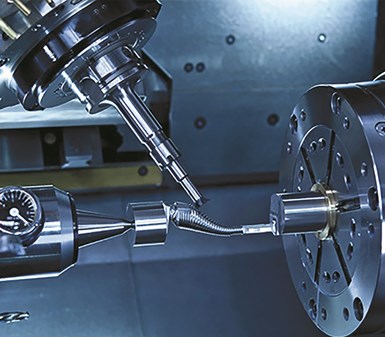Strict cleanliness regulations for machining medical components is one aspect of that industry that sets it apart from others. Machine shops that manufacture any kind of medical parts must be cautious about the type and quality of the materials they use, as well as their manufacturing processes, to ensure it is high quality before these machined devices come into contact with human cells. This includes using a coolant that is designed especially for medical machining.
These metalworking fluids are designed to be compatible with the high-end materials commonly used for medical applications. They also are designed to provide long tool and sump life, high-quality surface finishes and are free of substances that are typically restricted by medical manufacturers. These high-lubricity cutting fluids, such as Master Fluid Solutions’ Trim MicroSol 642RX, are formulated to be clean running, provide excellent tool life, are easy to remove and are low foaming.
While using advanced coolant formulated for medical applications can boost productivity and help a shop comply with chemical regulations, other factors besides coolant come into play to keep up with medical restrictions, according to Justin Geach, business development manager, North America at Master Fluid Solutions.
“In today’s age of continuously changing and increased chemical restrictions, medical manufacturers need to be sure they select the right (cutting fluid) products for their manufacturing, have the right cleaning processes in place, and complete all the proper testing — which may include cytotoxicity testing — especially for implantable devices,” Geach says.
Sustainable Substances
Machined medical parts are often subject to several process chemical restrictions that are frequently updated. For example, REACH (registration, evaluation, authorization and restriction of chemicals) compliance as well as SVHC (substances of very high concern) became even more stringent with revisions made in January 2022. There are also CMR (carcinogenic, mutagenic, reprotoxic) substances, Toxics Release Inventory chemicals (SARA 313), animal-derived raw materials and chlorine and other halogens that may be restricted by medical OEMs.
Coolants designed for medical machining applications are compatible with metals commonly used to create medical devices like this hip joint. They also are designed to provide long tool and sump life, high quality surface finishes and are free of substances that are typically restricted by medical manufacturers.
Photo Credit: Master Fluid Solutions
Because of these regulations, Master Fluid Solutions is only using sustainable substances in its medical coolant formulation.
“There has been a push for sustainability in both the chemical and medical industries,” Geach explains. “So, we have developed our medical-focused coolant with plant-based raw materials versus animal-based derivatives. Some medical manufacturers prohibit the use the of animal-based products, even if they meet rigorous processing restrictions.”
He adds that Master Fluid Solutions’ medical coolant will outlive the changing chemical requirements of the future because it is created without the use of harmful or often restricted chemicals. Yet, it can still provide excellent machining performance on medical-grade materials such as titanium, various aluminum alloys, stainless steel and nickel-based alloys that are commonly used in the industry.
Maintenance and Recycling
For any coolant, necessary preventive maintenance and recycling is important. However, it is especially crucial to ensure a clean medical machining application.
Concentration control, keeping coolant levels full on machine tools and removing tramp oil and other contaminants from coolant are all necessary aspects of regular maintenance. A coolant manufacturer can help with these procedures, Geach says. For example, a good supplier will provide lab testing for elemental and particle count analysis to determine if machine oils or metal fines are contaminating the coolant.
Recycling coolant is another way to pull tramp oil and fines out of the fluid to ensure the cleanliness necessary for medical machining. Starting with the best coolant possible and keeping it at peak performance by implementing recycling equipment leads to an easier parts cleaning process and results in the best tool life and finishes on machined parts while reducing fluid disposal Geach adds.
Not only does recycling clean the coolant but it reduces coolant usage and a manufacturer’s waste stream. It also lowers environmental impact and carbon footprint.
Master Fluid Solutions | masterfluids.com
Related Content
Some Assembly IS Required
This Colorado manufacturer added a separate facility dedicated to customer assembly work and inventory management to produce subassemblies and completed products primarily for medical customers.
Read MoreNew Cutting Tool Technology Discovered at Paul Horn Open House
During a tour of the company’s campus in Tubingen, Germany, I and more than 3,000+ others were introduced to a number of new advances the company has made in cutting tool technology particularly as it relates to the medical industry.
Read MoreGerman Project Yields Three New Medical Machining Processes
Recent research has resulted in a new mix of high-speed turn whirl milling, polygon turning and rotational turning for manufacturing medical bone screws and out-of-round nails.
Read MoreMoldmaker Finds Value in Swiss-Type Machining
This multifaceted manufacturer has added CNC sliding-headstock turning technology to complement its established mold tooling production and new injection molding capabilities as it continues to pursue complex medical work along a vertically integrated path.
Read MoreRead Next
6 Considerations for Metalworking Fluid Selection and Maintenance
Understanding how to select and maintain metalworking fluids is critical to a machine shop’s efficiency.
Read MoreRecycling System Cuts New Coolant Use in Half
Nebraska Machine Products Inc. found that using a coolant recycling system in conjunction with a chip wringer to filter and re-use water-soluble coolant helped it achieve a 50 percent savings on new coolant.
Read MoreMetalworking Fluid Management and Best Practices
Cutting metal is a complex process involving many critical factors to be successful. Correctly applied metalworking fluids, including oils or coolant, is one of these critical factors.
Read More














.jpg;maxWidth=300;quality=90)









